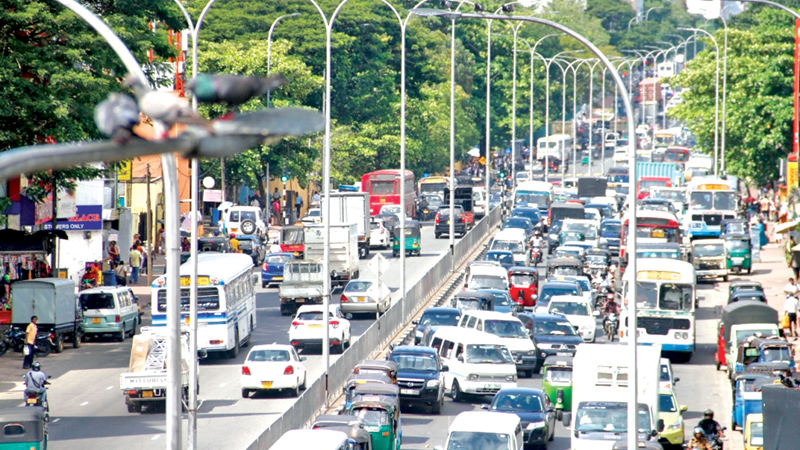A Detailed Overview of The Law of Sri Lanka on Traffic Lane

Having a clear idea about the traffic law in Sri Lanka is pretty much helpful for avoiding road accidents to a greater extent.
The traffic law in Sri Lanka is not newly introduced. It is a law established in the traffic law book. Recently the government started implementing it. Every vehicle must proceed in the left lane, and only when passing or making a right turn may a vehicle change to the right lane, as stated in Section 148 of the Motor Traffic Ordinance.
What is the traffic law in Sri Lanka?
We can explain it as simple as follows.
Vehicles should travel in the left lane on roads with traffic lanes 2 in one direction. The right traffic lane should be left blank. A vehicle should enter it only when overtaking and turning right. Vehicles entering the right lane to pass another vehicle must again enter the left lane after passing it. Drivers in the left lane should drive hard to the left as far as possible from the line dividing the two lanes.
Then what happens when there are three or more lanes?
Then you can drive in traffic lane 1 and traffic lanes 2 on the left. The driver should use the third lane to turn right and pass. Similarly, driving in two lanes is prohibited from driving vehicles in the middle of the broken line that separates the first and second lanes.
Vehicles should move one behind the other. For example, following a lorry, the drivers should not drive two three-wheelers or several motorcycles in parallel. All of them should go one after the other. In addition, stopping to block lanes and driving to block lanes are prohibited. Especially remember that overtaking on the left is prohibited. Tricycles and motorcyclists make this mistake frequently.
Has urban traffic congestion been reduced through the implementation of the lane law?
It is easier to travel on the road now. Also, the traffic has decreased significantly. The number of accidents has also decreased. All these factors have made it possible to travel and drive without stress.
Does the lane law apply to luxury vehicles? -Traffic Law in Sri Lanka
Elite vehicles are subject to lane law. But the lane law does not apply to vehicles the President and the Prime Minister travel. In addition, this law does not affect ambulances and fire engines that carry patients. Considering the practical conditions, vehicles carrying patients and vehicles assisting road accident victims have also been exempted from this law.
Apart from that, the VIP vehicles all ministers and security chiefs travel are subject to this law. Even the Commissioner of Police never ignores this law. Even if he is the head of the traffic police, he travels under this law.
Do expected results receive from traffic law?
According to a study, Sri Lanka needs to quadruple the number of roads at least once every ten years to handle the growing number of automobiles on the island nation’s highways. Plans fall through due to the traffic congestion on the roadways. Everyone interested in this issue agrees that fewer private vehicles should enter the city of Colombo, and the government should improve the public transportation system to reduce traffic around the city.
Why aren’t the motorists who violate the lane regulations issued a ticket and taken to court?
Those who disregard the lane regulations must pay fines. Some claim that the government implemented the lane law to levy penalties. This is untrue. The enforcement of this law has provided travelers with relief. Drivers will exhibit improved road discipline as they grow accustomed to this.
Why are fines not made simpler today with such cutting-edge technology?
Police are preparing to introduce a new technology that will let you pay fines with your phone. You can very quickly pay your fines in this manner. The future fine sheets will be issued for current court-presented infractions like using a phone while driving or not buckling up.
Traffic law – road signs
There are many traffic road signs when you learn traffic laws to drive in Sri Lanka. They are,
- Major road signs
- Warning signs
- prohibition signs
- Command signals
- Restriction signs
You may be following a traffic road map, but it’s essential to drive adhering to traffic road light to avoid a traffic road accident.
Why is it important to be concerned about Traffic Law in Sri Lanka?
Your focus and following traffic law in Sri Lanka are essential to stop accidents from happening. The World Health Organization (WHO) pointed this out in the road traffic accident statistics in 2016. Who road traffic injuries estimated in the year 2016 was 3,096. And road traffic injuries per 100,000 people in 2016 were 14.9. That means within 100,000 people, almost 15 people could die in a traffic road accident. Your concern on the road can save your life and another person’s life on the road.
Traffic road lines meaning?
The most typical lane markers are white. White lines with a solid background show where the road’s shoulder or delineate lanes of traffic traveling in the same direction. Broken or “dotted” white lines indicate the center line between lanes.
You can see where traffic is moving in different directions by looking for yellow lines. You can avoid dangerous head-on collisions with people traveling in the opposite direction by staying on your side of the yellow line.
Conclusion
Although traffic law in Sri Lanka has been in the traffic law book for a long time, lane law has recently been discussed. This is because the same traffic law in Sri Lanka had on its books is now being actively applied on the highways.
You must follow traffic laws, traffic road signs, traffic road lights, and traffic road lines when you follow a traffic road map to drive in Sri Lanka. It could help you to stop a traffic road accident one day.